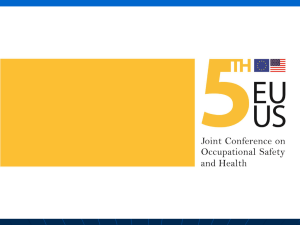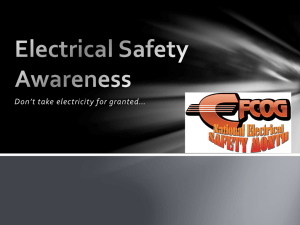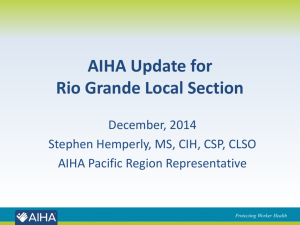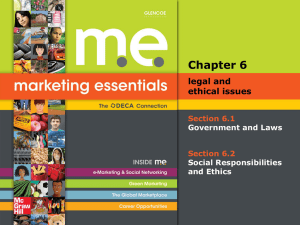What is IH for high school students
advertisement
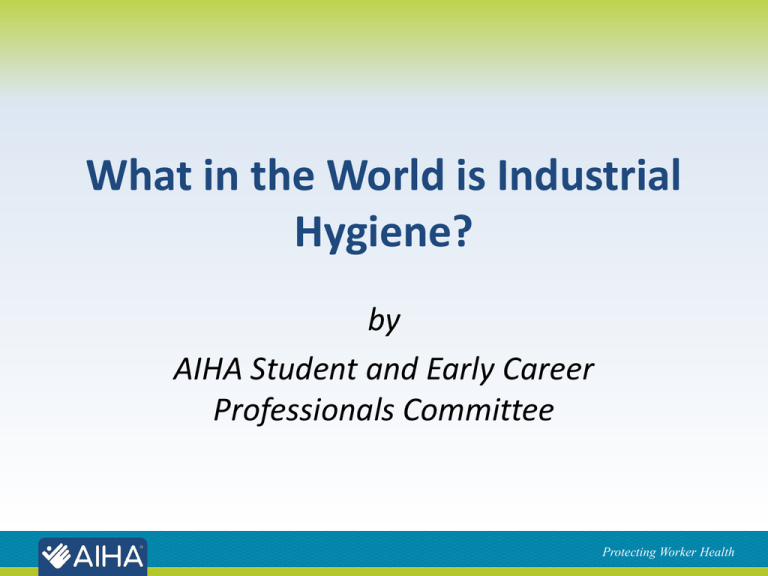
What in the World is Industrial Hygiene? by AIHA Student and Early Career Professionals Committee Protecting Worker Health Industrial Hygienist • IHs wear many different hats • Sometimes as a: – – – – – – – – Scientist Investigator Trainer/Educator Technician Policy enforcer Engineer Emergency Responder and more! Protecting Worker Health IH Defined • Industrial hygiene is the science of protecting and enhancing the health and safety of people at work and in their communities. • Health and safety hazards cover a wide range of chemical, physical, biological and ergonomic stressors. • Those dedicated to anticipating, recognizing, evaluating and controlling those hazards are known as industrial hygienists. Protecting Worker Health Industrial Hygiene/Occupational Health -EH&S (Environmental, Health & Safety) Protecting Worker Health Anticipation • Involves identifying potential hazards in the workplace before they are introduced. • Example – A funeral home employee (embalmer) works with embalming fluids that contain a carcinogen known as formaldehyde. – Is the employee being protected while working? • What is in the fluid, how does the employee use it, where is it being used and how often? Protecting Worker Health Recognition • Involves identifying the potential hazard that a chemical, physical or biological agent - or an adverse ergonomic situation - poses to health. • Example – The IH researches the chemicals (in this case formaldehyde) to understand the hazards and performs an assessment to determine how the employee(s) will be/are using it. • Interviews, inspects, reviews medical surveillance programs, health and epidemiology studies, worker health complaints, occupationally-related compensation claims, and industrial hygiene monitoring information. Protecting Worker Health Anticipate & Recognize Review • Anticipate or recognize things such as: – Chemical agents: gases, vapors, solids, fibers, liquids, dusts, mists, fumes, etc. – Physical agents: noise and vibration, heat and cold, electromagnetic fields, lighting etc. – Biological agents: bacteria , fungi, etc. – Ergonomic factors: lifting, stretching, and repetitive motion – Psychosocial factors: stress, workload and work organization • Once anticipated or recognized, the hazard can then be evaluated and eventually controlled to eliminate or reduce the impact of the hazard. Protecting Worker Health Evaluation • Evaluate the extent of the exposure. • This often involves measuring the personal exposure of a worker to the hazard/agent in the workplace and understanding what PPE they currently use. • Compare to SDS recommendations including occupational exposure limits, where such criteria exist. • Example – Depending on the use, the IH may collect personal breathing air samples to determine his/her exposure to help select the most appropriate PPE for inhalation. Absorption and ingestion potential will also be reviewed. Protecting Worker Health Control • Control by procedural, engineering or other means where the evaluation indicates that this is necessary. • Example – If results show the chemical is hazardous, the best idea is to find a less hazardous replacement or engineer a solution (e.g. ventilation). If not, adding administrative controls or adding PPE may be necessary. • Embalmers previously used arsenic. – They’ve replaced it with less hazardous (but still hazardous) formaldehyde • Ventilation may be added to control fumes • PPE such as gloves are used Protecting Worker Health Job Diversity • Industrial hygienists are not limited to one particular type of industry; they are employed in a variety of organizations such as: • • • • • Chemical companies Colleges and universities Government Insurance companies Manufacturing companies • • • • • Public utilities Research laboratories Consulting firms Hospitals Hazardous waste companies Protecting Worker Health Salary • The following figures are based on the 2013 AIHA Salary Survey. • As of June 30, 2013, the average mean salary for all respondents was $105,166, 25 percent of the respondents earned $80,000 or less, and 25 percent earned $124,239 or more. • The median was $100,000. Protecting Worker Health Questions? • To learn more, please visit the AIHA website: https://www.aiha.org/ • Education – Bachelor’s degree in engineering, chemistry, physics, or in a closely related biological or physical science major. – Twenty-two universities currently offer ABET accredited industrial hygiene master’s level programs. – Four universities offer ABET Accreditation of bachelor-level industrial hygiene programs. https://www.aiha.org/about-ih/IHcareers/ Protecting Worker Health The Right Thing to Do: What is IH? video (7.5 min) • https://www.youtube.com/watch?v=0k7GPW BoCa0 (produced by AIHA) Protecting Worker Health Perform Exercise • Ideas – Noise – sound level meter – Oxygen monitor – CO2 monitor (indoor vs. outdoor) – Velocity meter and fan – Light meter – Breathing zone air sample equipment demo – Colorimetric tubes & Bellows pumps Protecting Worker Health





